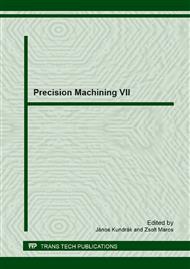[1]
J. Novak-Marcincin, J. Barna, L. Novakova-Marcincinova and V. Fecova: Analyses and Solutions on Technical and Economical Aspects of Rapid Prototyping Technology. Tehnicki Vjesnik - Technical Gazette, Vol. 18, No. 4, pp.657-661, ISSN 1330-3651, (2011).
DOI: 10.1063/1.4707641
Google Scholar
[2]
I. C. Dima, J. Gabrara, V. Modrak, P. Pachura, C. Popescu, Using the expert systems in the operational management of production. 11th WSEAS Int. Conf. on Mathematics and Computers in Business and Economics, MCBE '10, pp.307-312 (2010).
Google Scholar
[3]
T. Galeta, P. Raos and M. Somolanji: Impact of structure and building orientation on strength of 3D printed models. KGK Kautschuk Gummi Kunststoffe, Vol. 65, No. 10, pp.36-42, (2012).
Google Scholar
[4]
J. Novak-Marcincin, L. Novakova-Marcincinova, J. Barna and M. Janak: Application of FDM rapid prototyping technology in experimental gearbox development process. Tehnicki Vjesnik, Vol. 19, No. 3, pp.689-694, ISSN 1330-3651, (2012).
DOI: 10.1109/ines.2011.5954723
Google Scholar
[5]
J. Novak-Marcincin, M. Janak and L. Novakova-Marcincinova: Increasing of product quality produced by rapid prototyping technology. Manufacturing Technology, Vol. 12, No. 12, pp.71-75, ISSN 1213-2489 (2012).
DOI: 10.21062/ujep/x.2012/a/1213-2489/mt/12/1/71
Google Scholar
[6]
V. Modrak, J. Mandulak: Mapping development of MES functionalities. ICINCO 2009 - 6th International Conference on Informatics in Control, Automation and Robotics, Proceedings, 3 SPSMC, pp.244-247 (2009).
DOI: 10.5220/0002248902440247
Google Scholar
[7]
L. Novakova-Marcincinova and M. Janak: Application of progressive materials for RP technology. Manufacturing Technology, Vol. 12, No. 12, pp.76-79, ISSN 1213-2489, (2012).
DOI: 10.21062/ujep/x.2012/a/1213-2489/mt/12/1/75
Google Scholar
[8]
L. Novakova-Marcincinova, V. Fecova, J. Novak-Marcincin, M. Janak and J. Barna: Effective Utilization of RP Technology. Materials Science Forum, Vol. 713, pp.61-66, ISSN 1662-9752 (2012).
DOI: 10.4028/www.scientific.net/msf.713.61
Google Scholar
[9]
L. Novakova-Marcincinova, V. Fecova, J. Novak-Marcincin, M. Janak and J. Barna: Effective Utilization of Rapid Prototyping Technology. AIP Conference Proceedings, Vol. 1431, pp.834-841, ISSN 0094-243X, (2012).
DOI: 10.1063/1.4707641
Google Scholar
[10]
L. Novakova-Marcincinova, J. Novak-Marcincin, J. Barna, J. Torok: Special Materials Used in FDM Rapid Prototyping Technology Application. Proceedings of 16th International Conference on Intelligent Engineering Systems INES 2012, Lisbon, pp.73-76 (2012).
DOI: 10.1109/ines.2012.6249805
Google Scholar
[11]
L. Novakova-Marcincinova, J. Novak-Marcincin: Selected Testing for Rapid Prototyping Technology Operation. Applied Mechanics and Materials, Vol. 308, No. 1, pp.25-31 (2013).
DOI: 10.4028/www.scientific.net/amm.308.25
Google Scholar
[12]
D. Kovacevic, I. Budak, A. Antic, B. Kosec: Special Finite Elements: Theoretical background and Application, Tehnicki vejsnik Vol. 18, No. 4, pp.649-655, ISSN 1330-3651 (2011).
Google Scholar
[13]
L. Novakova-Marcincinova, J. Novak-Marcincin: Testing of the ABS Materials for Application in Fused Deposition Modeling Technology. Applied Mechanics and Materials, Vol. 309, No. 1, pp.133-140, ISSN 1662-7482 (2013).
DOI: 10.4028/www.scientific.net/amm.309.133
Google Scholar
[14]
P. Sugar, J. Sugarova, P. Zemko: Strain and Strain-hardening Analysis of Formed Parts Produced by Multi-Pass Metal Spinning, Tehnicki Vjesnik, 19, 1, pp.111-114, ISSN 1330-3651 (2012).
Google Scholar
[15]
J. Novak-Marcincin, J. Barna, J. Torok, L. Novakova-Marcincinova: Definition of Computer Aided Manufacturing Engineering and its Place in CA Systems Chain. Proceedings of 11th International Symposium on Applied Machine Intelligence and Informatics SAMI 2013, Herlany, pp.263-266, ISBN 978-1-4673-5927-6 (2013).
DOI: 10.1109/sami.2013.6480989
Google Scholar
[16]
J. Jurko, A. Panda, M. Gajdos: Accompanying phenomena in the cutting zone machinability during turning of stainless steels. International Journal of Machining and Machinability of Materials, Vol. 5, No. 4, pp.383-400, ISSN 1748-5711 (2009).
DOI: 10.1504/ijmmm.2009.026899
Google Scholar
[17]
K. Anna, S. Legutko: Productivity investigation within the ERP system. Manufacturing Technology, Vol. 12, No. 12, pp.34-38, ISSN 1213-2489 (2012).
DOI: 10.21062/ujep/x.2012/a/1213-2489/mt/12/1/34
Google Scholar


